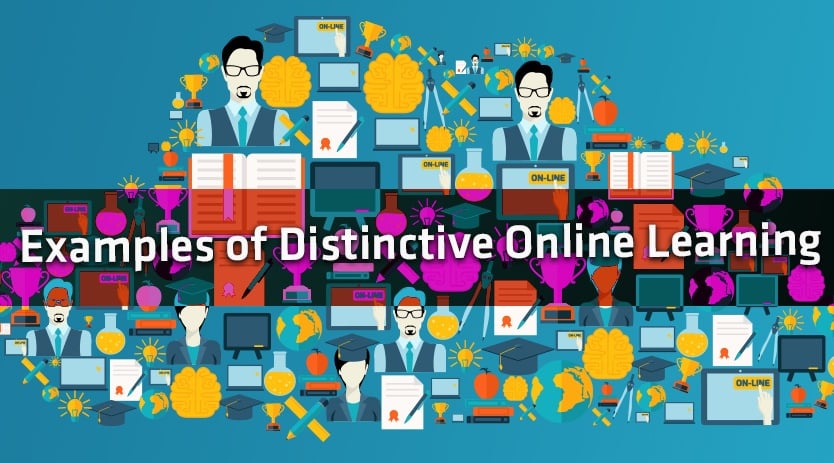In a previous post, I outline what it takes for an organization to move beyond the filmed movie stage of online learning to the point at which it is creating distinctive online learning experiences. To quote from that article: An online university class should not be the educational equivalent of a filmed play. It should deeply integrate new technologies for …
An online university class should not be the educational equivalent of a filmed play. It should deeply integrate new technologies for the benefit of both teachers and learners. It should not force old processes and resources into the new approach.
In order to create distinctive online learning experiences, a university’s platform, pedagogy, and content must be inseparable. In the following I describe three ways that an organization can create such experiences using today’s technologies.
Distinctive examples of integrated platform, pedagogy, and content
Astounding levels of targeted resources for the learner
The most straight-forward example of this is provided by edX’s CS50x from Harvard University. This course serves as an on-campus credit-bearing undergraduate course at both Harvard and Yale, as an AP computer science class, and as a MOOC (for a paid certificate or simply for the sake of learning). With the one million students who signed up for this course in the last year, this approach has been thoroughly stress-tested and is improved every year. This is an introduction to computer science course that is anything but basic:
- Recorded lectures: Each week there are two recorded 1-hour lectures given by Prof. David Malan in front of a large lecture hall at Harvard (or Yale). This is a highly produced and polished lecture that uses ad hoc student participants on stage, digital boards, and live code writing on stage.
- Community access: Students ask and answer questions on a variety of platforms, including Facebook — the important point being that they are platforms on which the student is comfortable working.
- Well-explained examples: The professor is recorded in 5-10 short videos explaining sample programs that he (usually) quickly referred to or discussed in that week’s lecture.
- Short technical video explanations: Student assistants are recorded in 5-15 highly professional, short 3-15 minute videos explaining specific technical details related to that week’s lecture and assignments.
- Integrated digital content creation: The assignments can all be completed through a Web page connected to a course-specific resource. This makes it very easy for students to get started, one of the big hurdles that has always gotten in the way of students learning to program.
- Problem-based learning: The assignment description is about 15 printed pages and is painstakingly complete. The problems are significant, seem realistic (e.g., implement a spell checker with a 140,000 word dictionary and run it against many texts, including the Austin Powers script and the complete works of Shakespeare), and are well explained. Tools are provided that allow the student to check his/her answers automatically without giving away how to arrive at the answer.
I could add more, but you get the idea. This is not a simple case of loading some videos and text on a Web site and calling it a class. It is so far beyond a standard face-to-face class because of the availability of a wide range and depth of computer-based resources as well as a wide variety of channels for getting help (either in person or virtually). Any school should think long and hard before they commit to continuing to offer their own course in lieu of adopting CS50x as its standard curriculum.
Personalized learning process
For many years (centuries?) the predominant standard of teaching has been based on the lecture. Certainly, at graduate (and also some remedial) levels of education, the mentor model has been employed, but at scale the lecture has been the standard. This provides a lock-step map for progress through the course, ensuring that each student is exposed to all topics in the course. Of course, it also for the most part ignores what a student already knows.
An alternative entails re-defining what it means to complete a course, moving away from the completion of a linear series of steps to the demonstration of knowledge. The tradition of equating time-spent-on-task with learning has a powerful hold on both academia and industry, so breaking with this tradition can be a politically difficult process. The two current major software based approaches are the following:
- adaptive: This approach focuses on changing the intensity and depth of instruction based on a student’s performance on assessments which are given throughout a course.
- competency-based education (CBE): This approach focuses on defining both a large set of competencies and associated ways of demonstrating mastery of those competencies. Less emphasis is placed on what a student does than on what knowledge and skills a student is able to effectively demonstrate.
Both of these approaches potentially allow a student to spend less time on the completion of a course. Further, in an effectively defined course, the student is able to spend all the time that is needed on his/her problematic sections. This should both clarify the meaning of what it means to pass a course as well as improve a student’s chances of passing that course.
Both adaptive and CBE approaches significantly change the definition of what it means to complete a course. Adoption of these approaches on a grand scale requires a commitment beyond simple adoption of a piece of edtech software. Neither of these approaches always work; further, neither one is inexpensive. However, both Western Governor's University and College for America, as well as a growing number of other institutions, have demonstrated that these approaches can be done cost effectively at scale. We have lots of data that shows that the in-person master-apprentice model both works well and is quite expensive. It is increasingly looking like benefit of these approaches is to deliver personalized education at scale, responding to the needs of individual learners with a computational educational infrastructure.
Computer-supported constructivist approach
The constructivist approach focuses on guiding the student to create an artifact that will be useful or applied in his/her life. The use of widely available tools on real world problems of personal interest to the student is a hallmark of this approach. While this approach is commonly used in small seminar classes, it can also be used in large MOOCs and everything in-between. Several different approaches might be employed in larger online classes:
- social support: As a student goes through the process of drafting, revising, and finalizing the project, he/she can get feedback from the community. The platform can support the process of coordinating the feedback, announcing the availability of the project for review, as well as facilitating the assessing of the people giving the feedback when appropriate.
- dynamic groups: After reaching specific milestones in a course, the platform dynamically creates groups of students who are at the same stage (and possibly in the same time zone, online at the same time, speak the same or different native languages, whatever the professor has specified to the algorithm) so that they can work together and give feedback to each other.
- simulations: The platform might have a student submit a spreadsheet (or program, or some other digital artifact) that fulfills some performance criteria. The platform would then assess the spreadsheet and provide feedback to the student. The key here is that the student is using some tool that he/she would use in his or her life, not some artificial, lives only in academia type of tool that has so frequently been used.
All of the vast amounts of content generated in these classes would not be useable or even manageable without the flexibility of a digital storage system. Further, each of the above approaches would not be possible without an underlying computational platform that supports the pedagogy in effect. All of them, but especially the simulations category, are similar to movie special effects — what is possible and but difficult to do today becomes accepted and not particularly noteworthy (or even noticed) tomorrow. This is the blessing and the curse of online learning: the state of the art is always advancing, so theory and practice must continually evolve. This doesn’t mean that an organization should wait until change slows down, but it does mean that most would benefit from a partner who specializes in the area.
How to create and run distinctive online learning experiences
Clearly it is possible given today’s technology and understanding of teaching & learning to design, implement, and run an online course at scale that is interesting, engaging, and effective. ExtensionEngine has the knowledge of the education market, pedagogical and design skills, technology expertise, and process management abilities to create and deliver such courses while working alongside your faculty. If this interests you, please send me an email so that we can explore your needs and interests.


